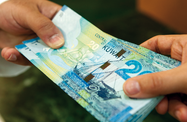Banking in Kuwait is undergoing a digital transformation, as the state’s strongest non-oil economic sector increasingly moves to meet demand from a young, tech-savvy population.

Private institutions have led the way, launching several new initiatives including biometric security systems and intelligent teller machines (ITMs), while others are moving to improve interoperability, e-payment systems and digital customer service delivery.
Recent efforts
After launching an innovation and digitisation department to improve online customer service delivery, National Bank of Kuwait (NBK) announced in May that it had opened a fully digital customer care centre in Bayan, as part of a strategy to move towards virtual branches and purely online service delivery.
In the same month, Kuwait Finance House (KFH) and Kuwait Credit Bank (KCB) revealed that they had signed a protocol agreement for electronic payments. Under current plans, KFH customers will be able to make payments to KCB through the KFH website, indicating that banks are becoming increasingly cognisant of the demand for interoperability and streamlined service delivery.
Gulf Bank has also been at the forefront of digital innovation in Kuwait, becoming the first bank in the Gulf region to launch a platform using biometrics for digital banking security, in May 2016.
In partnership with US-based biometric security firm Daon, Gulf Bank created a system combining touch ID and facial recognition technology. Customers can use the camera on their smartphone to scan their face while they blink their eyes, which grants access to mobile banking without typing authentication credentials.
In the second quarter of last year the bank also re-launched its online banking portal to improve functionality, and has established a small network of ITMs, which allow customers to make real-time video calls to banking professionals, eliminating the need to visit a local branch.
Islamic lender Boubyan Bank has also benefitted from digital adoption, reporting that assets, operational revenues and customer deposits rose by 18%, 17% and 15%, respectively, in 2015, on the back of a growing customer base. Rising customer numbers were attributed to new online and mobile banking offerings, highlighting the potential for digital innovation to augment banks’ revenues, profits and long-term growth.
Rising demand
The drive by lenders to enhance engagement with clients via technology and improve their digital offerings comes as a response to strong consumer demand.
In a May 2016 survey of 2000 Kuwaiti banking customers, consultancy EY reported that only 27% of clients’ banking interactions were made via smartphones, although it also found that 89% of banking customers in Kuwait would be prepared to switch banks to benefit from a better digital experience, while 80% would be willing to move to a “digital-first” bank.
Significantly, 90% of banking clients reported they would open an account with a digital-first bank with easy electronic payment methods and limited physical branches.
According to EY, customers have a good understanding of the benefits of digital banking, and would be happy to pay more for digital convenience. However, the survey also found that banks had work to do to enhance the online experience in order to see significant take up. A full 85% of respondents reported they had previously resisted using mobile banking, citing non-availability of a preferred digital channel, difficulty in accessing a digital platform, an unintuitive user experience, slow transaction speeds and lack of tailored services.
State of affairs
Despite ongoing subdued global oil prices, Kuwait’s banking sector has remained profitable and well capitalised, with NBK reporting that bank profits rose by 6.6% to hit KD190m ($626.1m) in the first quarter of this year, driven primarily by core income.
Digital adopters have also recorded positive financial results. Gulf Bank, for example, announced that its net profits rose by 9% year-on-year (y-o-y) in the first three months of the year to hit KD9.4m ($31m), while operating profits rose by 5% y-o-y, and 20% quarter-on-quarter to reach KD29.9m ($98.5m) – its highest first-quarter operating profit since 2010.
The bank’s net profits rose by 10% to KD43m ($141.7m) in 2016, with the lender reporting that its digital customer base increased by 156% following the launch of its mobile banking app in quarter two.
NBK, meanwhile, reports that its profits rose by 8.4% y-o-y in the first three months of 2017 to KD89.7m ($295.6m), after recording a 40% y-o-y profit increase to KD75.9m ($250.1m) in the fourth quarter of 2016.
Although the state’s banking sector has performed well in recent years, innovation could be a critical future growth driver, boosting profitability and enabling digital adopters to capture a larger market share, while offering new opportunities to financial technology, service, and security providers.


